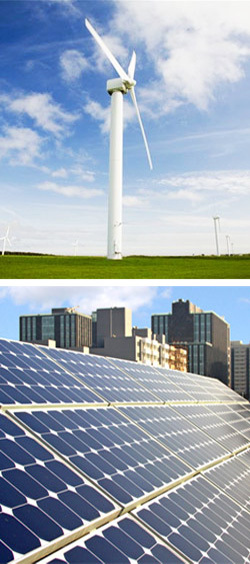Alternative energy
alternative energy
Wind turbines, solar panels, fuel cells. The requirements of these applications are related to environmental and geographical factors. Choosing the right materials for these devices is challenging, and they cannot break or deform due to long-term exposure to harsh environments.
1. Wind power generation is a renewable power generation method. It is now being widely promoted. Wind power generation is the conversion of kinetic energy into mechanical energy. The wind turns the blades, which turn the shaft connected to the generator.
2. Solar photovoltaic panels are a group of solar cells that convert light energy into electrical energy. Solar power generation is widely used, whether it is large-scale power generation or only to power a single home.
3. Fuel cells produce clean electricity. Can be heated without burning. It is an electrochemical device in which hydrogen reacts with oxygen to produce electricity, heat and water. Without the need for periodic recharging, the fuel cell receives a continuous supply of hydrogen and oxygen. Fuel cells are becoming increasingly popular in homes, offices, and even the automotive industry. Moulding Compound (BMC) has proven to be the preferred material for these critical applications.
Traditional materials may rust, creep or fade. BMC is favored by builders and end users in the field of alternative energy for the following reasons:
1. Enhanced structural hardness;
2. Corrosion resistance;
3. Excellent strength-to-weight ratio;
4. Weather resistance;
5. UV resistance;
6. Flame retardant.
Traditional roof building systems have been plagued by a series of problems such as weight, complex installation, high labor costs, poor insulation, and single color, and poor UV resistance. In recent years, solar roof systems have been developed, but this system can only provide electricity, and the energy efficiency is very low. Tractile has partnered with Atti Composites to develop an SMC material dedicated to its photovoltaic integrated roof photo-thermal integrated system. Since this photovoltaic integrated roof photoelectric thermal integration system needs to be exposed to the sun for a long time or eroded by other elements, the product requires that the material will not deform or deteriorate, and SMC material becomes the best choice. This photovoltaic integrated roof photothermal integrated system combines photovoltaic solar energy with hot water by introducing a heat transfer system into each tile. Pioneered the world's first integrated solar rooftop system solution that provides both electricity and hot water. Therefore, the photoelectric conversion efficiency is improved for the user, and the energy loss caused by the heating of the system is reduced, because these thermal energy losses directly convert the available hot water. This photovoltaic integrated roof photoelectric thermal integration system is a set of building integration scheme with aesthetic sense, which not only increases the benefit of photovoltaic output, but also reduces the time and cost of roof system production and installation. Due to the application of efficient and lightweight SMC materials, the weight of the whole roof system is reduced by 25%, but it is stronger than traditional roof materials. This system provides better UV resistance, thermal insulation, fire retardant, thermal stability, and a variety of colors.
These interlocking tiles can also be used as a fastening system for the mass market: roof systems, exterior wall systems, interior wall systems, flooring systems, ceiling systems, commercial building cladding, road and rail tunnel cladding, low-cost housing skins, military and defense systems, etc.


